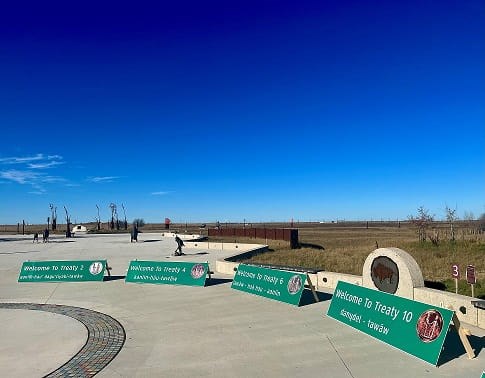REGINA — The Government of Saskatchewan and the Office of the Treaty Commissioner have unveiled a series of new highway signs to be placed in the Estevan, Moosomin, Lanigan and La Ronge areas to highlight more Treaty boundaries across the province.
The four pairs of signs will be installed on:
- Highway 39 near Estevan to mark the Treaty 2-Treaty 4 Boundary, where more than 4,600 vehicles travel daily.
- Trans-Canada Highway 1 near Moosomin to also mark another Treaty 2-Treaty 4 Boundary, where more than 5,300 vehicles travel daily.
- Yellowhead Trans-Canada Highway 16 near Lanigan to mark the Treaty 4-Treaty 6 Boundary, where more than 2,900 vehicles travel daily.
- Highway 2/102 near La Ronge to mark the Treaty 6-Treaty 10 Boundary, where about 1,000 vehicles travel daily.
Each of these new signs incorporates:
- Indigenous languages specific to their locations.
- The phrase that represents the spirit and intent of the Treaties, "as long as the sun shines, grass grows and rivers flow."
- The treaty medals provided to First Nations following the treaty negotiations.
These new signs will join two others installed last year when a historic Saskatchewan milestone was reached with the unveiling of inaugural signs marking the Treaty 4-Treaty 6 Boundary along Highway 11 between Saskatoon and Regina.
The Treaty signs have been manufactured in Saskatchewan by SAGE Roadways, a division of Saskatoon-based JNE Welding LP., which is majority-owned by the Peter Ballantyne Group of Companies, and Des Nedhe Group, an English River First Nation Enterprise.
"Thousands of daily commuters and tourists will see these signs on their driving routes, which can help start and continue important conversations about Treaties in Saskatchewan," Highways Minister Lori Carr said.
"These signs allow people to recognize and understand the Treaty territories that were here long before the creation of the province," Treaty Commissioner of Saskatchewan Mary Musqua-Culbertson said. "The highways cross these territories and it is important that it is acknowledged."
Bookmark SASKTODAY.ca, Saskatchewan's home page, at this link.




